标语翻译的文本分析和翻译策略
- 格式:pptx
- 大小:1.07 MB
- 文档页数:18

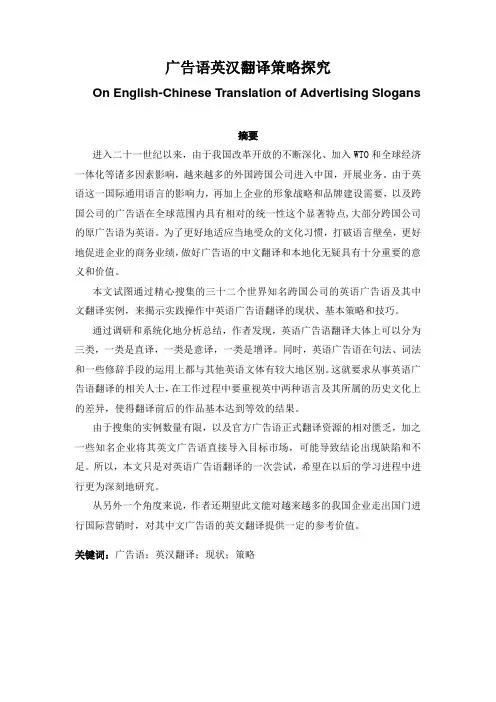
广告语英汉翻译策略探究On English-Chinese Translation of Advertising Slogans摘要进入二十一世纪以来,由于我国改革开放的不断深化、加入WTO和全球经济一体化等诸多因素影响,越来越多的外国跨国公司进入中国,开展业务。
由于英语这一国际通用语言的影响力,再加上企业的形象战略和品牌建设需要,以及跨国公司的广告语在全球范围内具有相对的统一性这个显著特点,大部分跨国公司的原广告语为英语。
为了更好地适应当地受众的文化习惯,打破语言壁垒,更好地促进企业的商务业绩,做好广告语的中文翻译和本地化无疑具有十分重要的意义和价值。
本文试图通过精心搜集的三十二个世界知名跨国公司的英语广告语及其中文翻译实例,来揭示实践操作中英语广告语翻译的现状、基本策略和技巧。
通过调研和系统化地分析总结,作者发现,英语广告语翻译大体上可以分为三类,一类是直译,一类是意译,一类是增译。
同时,英语广告语在句法、词法和一些修辞手段的运用上都与其他英语文体有较大地区别。
这就要求从事英语广告语翻译的相关人士,在工作过程中要重视英中两种语言及其所属的历史文化上的差异,使得翻译前后的作品基本达到等效的结果。
由于搜集的实例数量有限,以及官方广告语正式翻译资源的相对匮乏,加之一些知名企业将其英文广告语直接导入目标市场,可能导致结论出现缺陷和不足。
所以,本文只是对英语广告语翻译的一次尝试,希望在以后的学习进程中进行更为深刻地研究。
从另外一个角度来说,作者还期望此文能对越来越多的我国企业走出国门进行国际营销时,对其中文广告语的英文翻译提供一定的参考价值。
关键词:广告语;英汉翻译;现状;策略AbstractWith the further development of China’s revolution and opening-up and China’s entry into WTO, more and more foreign multi-national corporations (MNC) have entered Chinese market to set up their business. Most MNC’s original advertising slogans are in English for the reason that English is the dominating language internationally. Besides, their slogans are consistent in global market to meet the requirement of MNCs’ identity strategy and brand building policy. However, for Chinese local target consumers’better awareness of the brand key message and promotion of company business, it is absolutely necessary to translate and localize the English slogans into Chinese.This paper examines 32 representative English advertising slogans of world famous brands and their corresponding translated Chinese versions. Based on this, the paper tries to explore the strategies and techniques of the E-C advertising slogans translation.Through the research result, we could infer how some basic translation strategies applied, people’s common practices and some unique features in advertisement slogan translation. The author finds out that E-C advertising slogans translation could be categorized into three groups: literal translation, free translation and meaning-add translation. Besides, English advertising slogans are much different from other texts in syntax, morphology and rhetoric. To make sure translation results carries same meanings with the original ones, the person working on English advertising slogans translation should pay attention to the cultural difference.The weakness of this research lie in that samples collected may not be adequate and typical enough due to the resource for official slogan translation is limited plus some famous companies adopt the English original directly even in a foreign market.The author hopes based on his attempt, more investigation would be carried out in thisarea in the future study. Meanwhile the researcher also hopes this research would be viewed as reference when we translate Chinese advertising slogans into English for national companies’ global marketing.Key words:Advertising Slogan; E-C Translation; StrategiesTable of contentsPages1. Introduction -----------------------------------------------------------------------------------------1.1 Research Backgroud --------------------------------------------------------------------------1.2 Research Objective ----------------------------------------------------------------------------1.3 Project Design ----------------------------------------------------------------------------------- 1 1 2 22. Rationale ----------------------------------------------------------------------------------------------2.1 Definition of Advertising Slogan ----------------------------------------------------------2.2 The linguistic features of English Advertising Slogan -----------------------------2.2.1 Morphology in English Advertising slogan ----------------------------------2.2.2 Syntax in English Advertising Slogan -----------------------------------------2.2.3 Rhetorical Devices in English Advertising slogan -------------------------2.3 Translation Principles ---------------------------------------------------------------------2.4 Translation Strategies ------------------------------------------------------------------------- 2 2 3 3 3 4 4 53.Description of the Data ----------------------------------------------------------------------- 64. Data Analysis ---------------------------------------------------------------------------------------4.1 Anlysis of the Two Language Versions ------------------------------------------------4.1.1 Three Main Translation Methods --------------------------------------------------4.1.2 The Other Unique Translation Ways in Chinese Culture ------------------4.2 Summary ------------------------------------------------------------------------------------------ 6 6 6 7 75. Results and Suggestions -------------------------------------------------------------------- 95.1 Results ----------------------------------------------------------------------------------------------5.1.1 Some Common Skills ------------------------------------------------------------------5.1.2 The Unique Features of Advertising Slogans Translation ----------------- 5.2 Suggestions on the Use of Translating Strategies -----------------------------------9 10 10 106. Conclusion --------------------------------------------------------------------------------------------- 10 Bibliography ----------------------------------------------------------------------------------------------- 12 Appendix: --------------------------------------------------------------------------------------------------- 13On English-Chinese Translation of Advertising Slogans1. Introduction1.1 Research Background1.1.1 Why advertisement?The modern advertisement that originated in western countries undoubtedly has great influences on the entire human society. Corporations of every field cast billions of dollars into advertisement every year, lay over every kind of media, launch so many campaigns and hire a great number of famous people for their prolocutors. According to the survey, the global advertising expenditure in 2000 is about 410 billion US dollars. In China, the very next year after the carrying out of reform and opening-up in 1978, i.e. 1979, was called the first year of comprehensive recovery Chinese advertisement field. Nowadays, Chinese people find that they have been surrounded by various kinds of advertisements. Obviously, as the reform and opening-up further develops, advertisement would play a more and more important role in our state economy and people’s life.At personal level, the author is much interested in advertising especially in copy writing. Also the author has certain experiences in drafting, translating and polishing advertisements.1.1.1 Why slogans?In the advertising identification and communication, advertising slogans have held a unique and irreplaceable position. Nowadays, more and more international famous companies have endowed advertising slogans with prior status and regarded them as an important part of their strategy development, which includes brand building, corporation culture shaping, product characteristics and corporation identification system.1.1.1 Why E-C?Based on the fact that China’s advertisement started relatively late, the references and models mainly are English advertisements, especially the foreign and joint ventureadvertising companies dominated the modern Chinese advertising market. Therefore, The scope of the thesis is mainly covered by practical examples from English advertising slogans, translation strategies based on comparative studies of translation examples and their original versions.1.2 Research ObjectiveThrough the research the author aims to accomplish the following objectives:1) The basic translation rules applied to E-C advertising slogans translation;2) To summarize the research and look into the future of English advertising slogan and its translation.To fulfill this project, the author will better understand advertising slogan’s language characteristics and improve translation skills. Also it will enable the researcher create better advertising slogans, bring the more smooth and proper sense of foreign advertising slogans to our nation’s consumers.1.3 Project DesignThe research is divided into four parts. In part one, the author will define advertising slogans and describe the main theories related to the study. In part two, the author will go further into the study of E-C advertising slogan translation by examining 32 carefully-chose examples and their translations. In part three, the author aims to summarize E-C advertising slogan translation strategies according to the data analysis, and also find the important factors which affect on the translator’s decision-making of translation strategies as well as offer suggestions for the practice of advertising slogan translation. Finally, in part four, the author will summarize the whole research and present the implications for the future practice and research.2. Rationale2.1 Definition of Advertising SloganSince this project aims to explore the E-C translation strategies of advertising slogans, we should first look into what is advertising slogan. According to the Definition Committee of American Marketing Association(方薇, 1997, p2), advertising isdefined as follows: Advertising is the non-personal communication of information usually paid for and usually persuasive in nature about products, services or ideas by identified sponsors through the various media. The Oxford Dictionary 6th edition explains slogan as “a word or phrase that is easy to remember, used for example by a political party or in advertising to attract people’s attention or to suggest an idea quickly”. (Advanced learner’s English-Chinese Dictionary, The Commercial Press & Oxford University Press)Slogan: A standard company statement (also called a tag line or a theme line) for advertisements, salespeople, and company employees. Slogans have two basic purposes: to provide continuity for a campaign and to reduce a key theme or idea to a brief, memorable positioning statement. (戚云方,2003, p375)To compare and summarize the above definitions, we can infer that advertising slogan is short sentence that could enhance impression and make focus swiftly.2.2 The linguistic features of English Advertising slogan2.2.1 Morphology in English Advertising SloganEnglish advertising slogan has particular characteristics; it is different from daily English.1) A lot of verbs especially monosyllable are used. For example, get, make, give, like, love, buy, need, use, etc. For example:I’m lovin’ it. McDonald’s 我就喜欢Buy One Get One Dannon 买一赠一2) Adjectives are often used, but using highest adjective on products are usually avoided. For example:New Beijing, Great Olympics Beijing 2008 Olympic Games 新北京,新奥运Let’s make things better Philips 让我们做的更好3) Adjective or attributive phrases are added before nouns. For example:Easy In and Easy Out Swivel 进出自如4) Agreat number of compound, usually hyphenated compounds are adopted. For example:The All-New MITSUBISHI Mirage Coupe MITSUBISHI Motor全新的三菱幻想双座轿车Home-baked taste by the spoonful Betty Crocker满口家常菜的味道2.2.2 Syntax in English Advertising Slogan1) Simple sentence is mostly used.Impossible Is Nothing ADIDAS 没有不可能Just Do It NIKE 只管去做2) To adopt interrogative and imperative sentence.Have you driven a Ford lately? FORD MOTOR 你最近开过福特车吗?Get the feeling Sports Illustrated 身临其境3) Disjunctive sentence.Yes.Avis is all over Asia Pacific. Avis Rent Car 是的。

广告英语的语言特色、翻译标准及策略随着全球化的加速和市场竞争的激烈化,广告已成为商业推销不可或缺的一环。
而广告英语作为广告营销的重要手段之一,其语言特色、翻译标准及策略也越来越受到重视。
本文将从这三个方面对广告英语进行探讨。
一、广告英语的语言特色1.简洁明了广告英语追求简洁明了,力求用最少的词汇和最简单的语言表达最多的信息。
例如,著名的“Just Do It”(只管去做)这个口号,用了三个简单的词汇,却能深入人心,成为了耳熟能详的品牌标语。
2.夸张与幽默广告英语善于利用夸张和幽默的手法,吸引消费者的注意力。
这些夸张和幽默的手法往往使广告具有娱乐性和亲和力,从而提高了广告的传播效果。
例如,可口可乐的广告常常会采用夸张和幽默的手法,吸引消费者的目光。
3.感性化广告英语往往采用感性化的语言,利用情感的力量来引导消费者的购买行为。
例如,花旗银行的广告口号“Live Richly”(丰富你的人生),通过引发消费者的情感共鸣,激发了他们的消费欲望。
二、广告英语的翻译标准1.忠实传达信息广告英语的翻译应该忠实传达原文信息,保证广告的准确性和完整性。
同时,翻译应该注意原文的文化背景和语境,选择恰当的翻译方式和表达方式,使广告信息传达到目标消费者。
2.符合本地化需求广告英语的翻译还应该符合本地化需求,考虑到不同地区、不同文化和语言的差异,选择适合目标消费者的语言和表达方式,增强广告的可读性和可接受性。
3.保持广告特色广告英语的翻译不仅要忠实传达信息和符合本地化需求,还应该保持广告的特色和风格,保留原文的创意和感性化语言,以确保广告的传达效果。
三、广告英语的翻译策略1.直译直译是广告英语翻译的常见策略之一。
直译可以保持原文的准确性和完整性,同时也能传达广告的语言特色和风格。
然而,直译也存在一定的局限性,可能无法传达原文的情感和创意,也可能会造成语言不通顺的问题。
因此,在使用直译策略时,需要注意语言的通顺和逻辑性,并尽可能保留原文的情感和感性化语言。
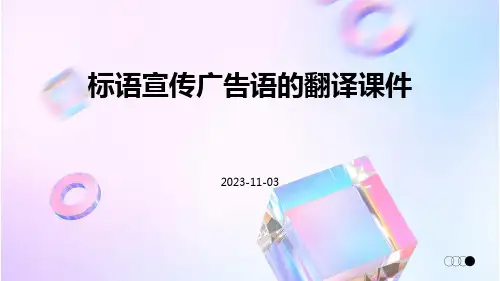
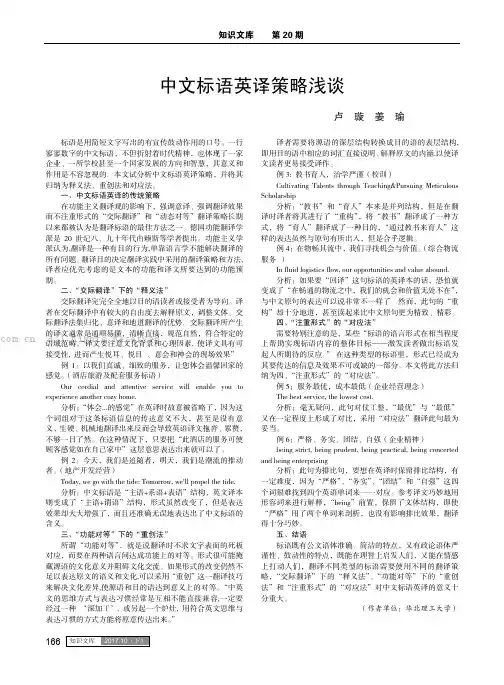
知识文库 第20期166 中文标语英译策略浅谈卢璇姜瑜标语是用简短文字写出的有宣传鼓动作用的口号。
一行寥寥数字的中文标语,不但折射着时代精神,也体现了一家企业、一所学校甚至一个国家发展的方向和智慧,其意义和作用是不容忽视的。
本文试分析中文标语英译策略,并将其归纳为释义法、重创法和对应法。
一、中文标语英译的传统策略在功能主义翻译观的影响下,强调意译、强调翻译效果而不注重形式的“交际翻译”和“动态对等”翻译策略长期以来都被认为是翻译标语的最佳方法之一。
德国功能翻译学派是20世纪八、九十年代由赖斯等学者提出。
功能主义学派认为,翻译是一种有目的行为,单靠语言学不能解决翻译的所有问题。
翻译目的决定翻译实践中采用的翻译策略和方法,译者应优先考虑的是文本的功能和译文所要达到的功能预期。
二、“交际翻译”下的“释义法”交际翻译完完全全地以目的语读者或接受者为导向。
译者在交际翻译中有较大的自由度去解释原文,调整文体。
交际翻译法集归化、意译和地道翻译的优势。
交际翻译所产生的译文通常是通顺易懂,清晰直接,规范自然,符合特定的语域范畴。
“译文要注意文化背景和心理因素, 使译文具有可接受性, 进而产生悦耳、悦目 、意会和神会的现场效果”例1:以我们真诚、细致的服务,让您体会温馨回家的感觉。
(酒店旅游及配套服务标语)Our cordial and attentive service will enable you to experience another cozy home.分析:“体会...的感觉”在英译时故意被省略了,因为这个词组对于这条标语信息的传达意义不大,甚至是没有意义,生硬、机械地翻译出来反而会导致英语译文拖沓、累赘,不够一目了然。
在这种情况下,只要把“此酒店的服务可使顾客感觉如在自己家中”这层意思表达出来就可以了。
例2:今天,我们是追随者,明天,我们是潮流的推动者。
(地产开发经营)Today, we go with the tide; Tomorrow, we'll propel the tide.分析:中文标语是“主语+系语+表语”结构,英文译本则变成了“主语+谓语”结构,形式虽然改变了,但是表达效果却大大增强了,而且还准确无误地表达出了中文标语的含义。
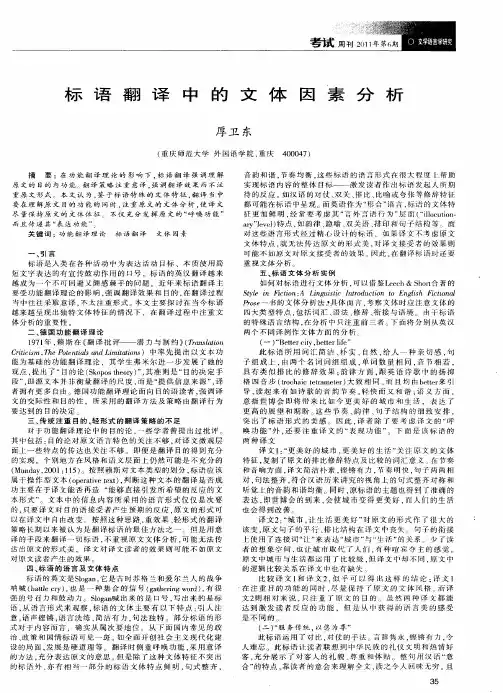
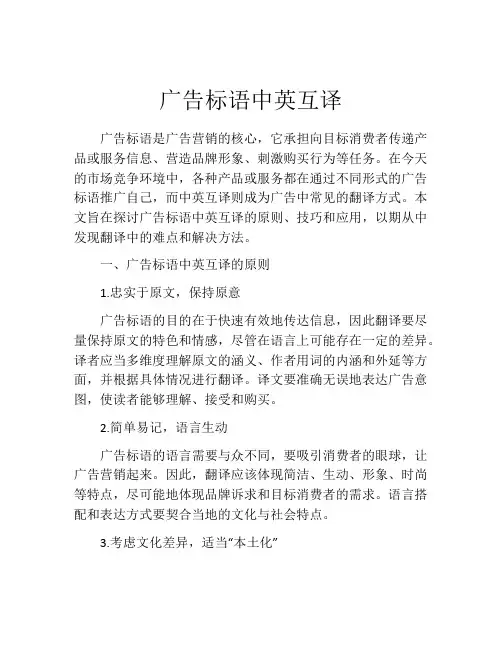
广告标语中英互译广告标语是广告营销的核心,它承担向目标消费者传递产品或服务信息、营造品牌形象、刺激购买行为等任务。
在今天的市场竞争环境中,各种产品或服务都在通过不同形式的广告标语推广自己,而中英互译则成为广告中常见的翻译方式。
本文旨在探讨广告标语中英互译的原则、技巧和应用,以期从中发现翻译中的难点和解决方法。
一、广告标语中英互译的原则1.忠实于原文,保持原意广告标语的目的在于快速有效地传达信息,因此翻译要尽量保持原文的特色和情感,尽管在语言上可能存在一定的差异。
译者应当多维度理解原文的涵义、作者用词的内涵和外延等方面,并根据具体情况进行翻译。
译文要准确无误地表达广告意图,使读者能够理解、接受和购买。
2.简单易记,语言生动广告标语的语言需要与众不同,要吸引消费者的眼球,让广告营销起来。
因此,翻译应该体现简洁、生动、形象、时尚等特点,尽可能地体现品牌诉求和目标消费者的需求。
语言搭配和表达方式要契合当地的文化与社会特点。
3.考虑文化差异,适当“本土化”译者应该注意中英两种文化的区别和异同,确保译文呈现给消费者时不会引起歧义或误解。
在某些情况下,翻译还需要适当“本土化”,使其更符合当地文化特点和消费者的审美习惯。
这样才能实现广告标语的最大化价值。
二、广告标语中英互译的技巧1.意译和直译并用理解原文含义是中英互译的基本前提。
根据需要,译者可以采用意译或直译的方法来表达原文意思和情感。
有的标语非常生动形象,摆脱了语言的束缚,需要更多的意译,而有些则通过直接翻译表达信息和情感。
具体来说,中文的谚语或成语在英语广告中采用意译的方法,英语习语在中文广告中采用直译的方法。
2.注意词汇和句式的变化不同语言之间的词汇和句式有很大差异,因此在翻译中要考虑到这一点。
比如英语广告中的句式通常比较封闭,简洁明了,而中文则更多的采用类似于议论文的语言方式。
此外,翻译还要注意搭配和语法上的差异。
比如英语中,一些简短的修饰词往往可以成为独立的修饰语,而中文则需要与主语合一。
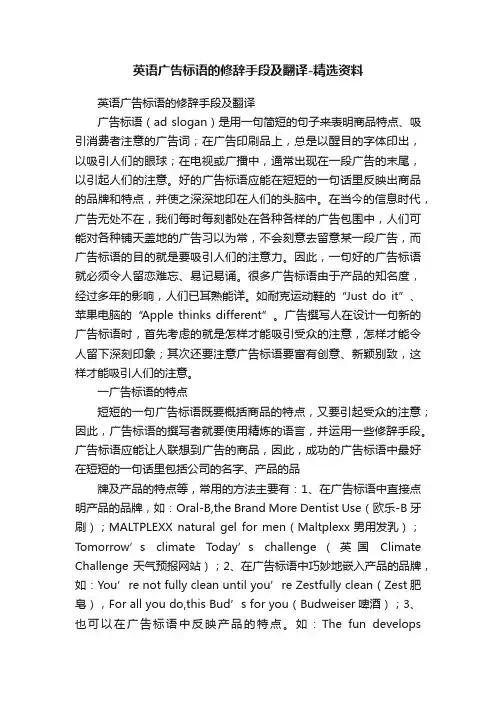
英语广告标语的修辞手段及翻译-精选资料英语广告标语的修辞手段及翻译广告标语(ad slogan)是用一句简短的句子来表明商品特点、吸引消费者注意的广告词;在广告印刷品上,总是以醒目的字体印出,以吸引人们的眼球;在电视或广播中,通常出现在一段广告的末尾,以引起人们的注意。
好的广告标语应能在短短的一句话里反映出商品的品牌和特点,并使之深深地印在人们的头脑中。
在当今的信息时代,广告无处不在,我们每时每刻都处在各种各样的广告包围中,人们可能对各种铺天盖地的广告习以为常,不会刻意去留意某一段广告,而广告标语的目的就是要吸引人们的注意力。
因此,一句好的广告标语就必须令人留恋难忘、易记易诵。
很多广告标语由于产品的知名度,经过多年的影响,人们已耳熟能详。
如耐克运动鞋的“Just do it”、苹果电脑的“Apple thinks different”。
广告撰写人在设计一句新的广告标语时,首先考虑的就是怎样才能吸引受众的注意,怎样才能令人留下深刻印象;其次还要注意广告标语要富有创意、新颖别致,这样才能吸引人们的注意。
一广告标语的特点短短的一句广告标语既要概括商品的特点,又要引起受众的注意;因此,广告标语的撰写者就要使用精炼的语言,并运用一些修辞手段。
广告标语应能让人联想到广告的商品,因此,成功的广告标语中最好在短短的一句话里包括公司的名字、产品的品牌及产品的特点等,常用的方法主要有:1、在广告标语中直接点明产品的品牌,如:Oral-B,the Brand More Dentist Use(欧乐-B牙刷);MALTPLEXX natural gel for men(Maltplexx男用发乳);Tomorrow’s climate Today’s challenge(英国Climate Challenge天气预报网站);2、在广告标语中巧妙地嵌入产品的品牌,如:You’re not fully clean until you’re Zestfully clean(Zest肥皂),For all you do,this Bud’s for you(Budweiser啤酒);3、也可以在广告标语中反映产品的特点。
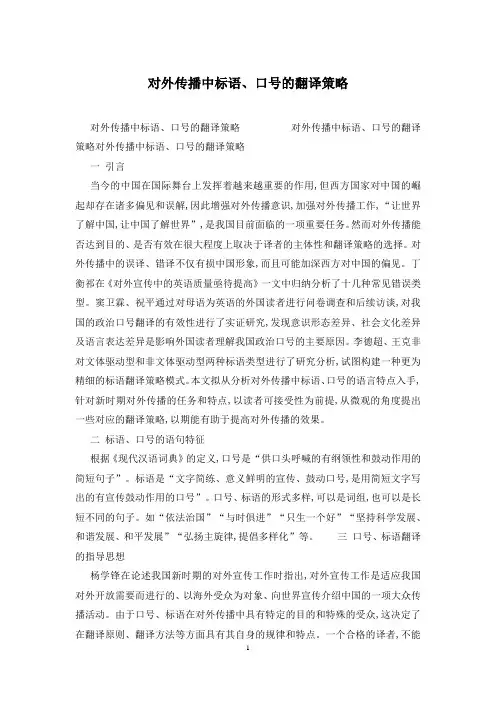
对外传播中标语、口号的翻译策略对外传播中标语、口号的翻译策略对外传播中标语、口号的翻译策略对外传播中标语、口号的翻译策略一引言当今的中国在国际舞台上发挥着越来越重要的作用,但西方国家对中国的崛起却存在诸多偏见和误解,因此增强对外传播意识,加强对外传播工作,“让世界了解中国,让中国了解世界”,是我国目前面临的一项重要任务。
然而对外传播能否达到目的、是否有效在很大程度上取决于译者的主体性和翻译策略的选择。
对外传播中的误译、错译不仅有损中国形象,而且可能加深西方对中国的偏见。
丁衡祁在《对外宣传中的英语质量亟待提高》一文中归纳分析了十几种常见错误类型。
窦卫霖、祝平通过对母语为英语的外国读者进行问卷调查和后续访谈,对我国的政治口号翻译的有效性进行了实证研究,发现意识形态差异、社会文化差异及语言表达差异是影响外国读者理解我国政治口号的主要原因。
李德超、王克非对文体驱动型和非文体驱动型两种标语类型进行了研究分析,试图构建一种更为精细的标语翻译策略模式。
本文拟从分析对外传播中标语、口号的语言特点入手,针对新时期对外传播的任务和特点,以读者可接受性为前提,从微观的角度提出一些对应的翻译策略,以期能有助于提高对外传播的效果。
二标语、口号的语句特征根据《现代汉语词典》的定义,口号是“供口头呼喊的有纲领性和鼓动作用的简短句子”。
标语是“文字简练、意义鲜明的宣传、鼓动口号,是用简短文字写出的有宣传鼓动作用的口号”。
口号、标语的形式多样,可以是词组,也可以是长短不同的句子。
如“依法治国”“与时俱进”“只生一个好”“坚持科学发展、和谐发展、和平发展”“弘扬主旋律,提倡多样化”等。
三口号、标语翻译的指导思想杨学锋在论述我国新时期的对外宣传工作时指出,对外宣传工作是适应我国对外开放需要而进行的、以海外受众为对象、向世界宣传介绍中国的一项大众传播活动。
由于口号、标语在对外传播中具有特定的目的和特殊的受众,这决定了在翻译原则、翻译方法等方面具有其自身的规律和特点。
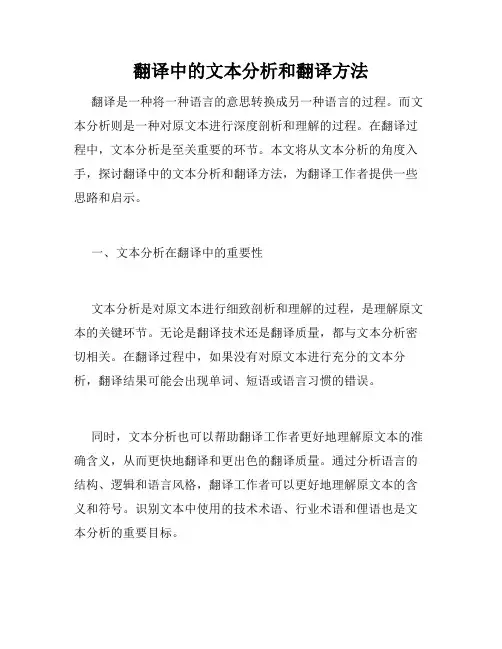
翻译中的文本分析和翻译方法翻译是一种将一种语言的意思转换成另一种语言的过程。
而文本分析则是一种对原文本进行深度剖析和理解的过程。
在翻译过程中,文本分析是至关重要的环节。
本文将从文本分析的角度入手,探讨翻译中的文本分析和翻译方法,为翻译工作者提供一些思路和启示。
一、文本分析在翻译中的重要性文本分析是对原文本进行细致剖析和理解的过程,是理解原文本的关键环节。
无论是翻译技术还是翻译质量,都与文本分析密切相关。
在翻译过程中,如果没有对原文本进行充分的文本分析,翻译结果可能会出现单词、短语或语言习惯的错误。
同时,文本分析也可以帮助翻译工作者更好地理解原文本的准确含义,从而更快地翻译和更出色的翻译质量。
通过分析语言的结构、逻辑和语言风格,翻译工作者可以更好地理解原文本的含义和符号。
识别文本中使用的技术术语、行业术语和俚语也是文本分析的重要目标。
二、文本分析的方法1、句法分析句法分析是一种对原文本句子进行分析的方法。
翻译者可以通过分析句子的主语、谓语和宾语等成分来理解句子的结构和含义。
有时候,翻译工作者还需要添加一些不在原文本中的单词和语法成分,以便将原句翻译成目标语言的正确句子。
2、语义分析语义分析是一种对原文本语言的意义和含义进行分析的方法。
翻译工作者可以通过检查单词和信号词的含义,理解原文本的意义以及与其相关的空间和时间背景。
语义分析需要翻译者具备足够的知识储备,才能理解各个行业和学科领域的专业术语和技术描述。
3、文化分析文化分析是一种对原文本背景和文化环境进行分析的方法。
在翻译过程中,翻译者需要了解源语言的文化特性以及目标语言的文化特性。
虽然同一语言有不同的文化背景,但文化背景对翻译的影响更为明显。
翻译工作者需要通过对宗教、社会习俗、历史和地理环境等方面的了解,调整翻译文本的语言风格,以避免翻译不当的尴尬和问题。
三、翻译中的翻译技巧1、遵循意译原则意译原则是翻译工作者在翻译时必须遵循的一个重要原则。
翻译工作者在翻译过程中必须根据目标语言的语言习惯和文化背景,对原文本进行适当的调整和转换,以维护原文本的核心含义。
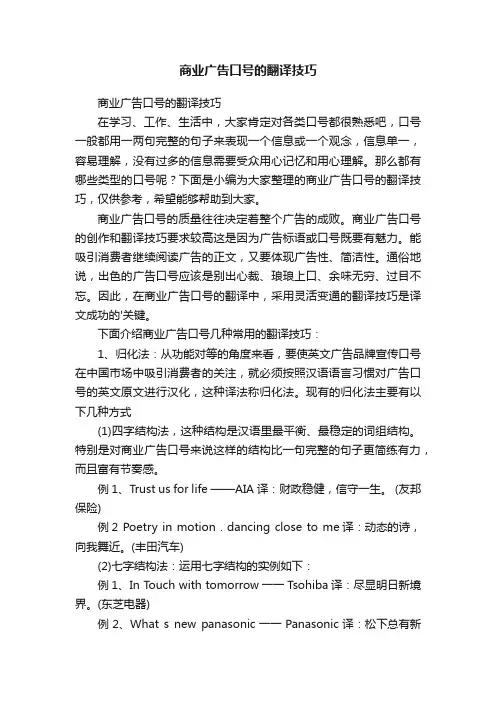
商业广告口号的翻译技巧商业广告口号的翻译技巧在学习、工作、生活中,大家肯定对各类口号都很熟悉吧,口号一般都用一两句完整的句子来表现一个信息或一个观念,信息单一,容易理解,没有过多的信息需要受众用心记忆和用心理解。
那么都有哪些类型的口号呢?下面是小编为大家整理的商业广告口号的翻译技巧,仅供参考,希望能够帮助到大家。
商业广告口号的质量往往决定着整个广告的成败。
商业广告口号的创作和翻译技巧要求较高这是因为广告标语或口号既要有魅力。
能吸引消费者继续阅读广告的正文,又要体现广告性、简洁性。
通俗地说,出色的广告口号应该是别出心裁、琅琅上口、余味无穷、过目不忘。
因此,在商业广告口号的翻译中,采用灵活变通的翻译技巧是译文成功的'关键。
下面介绍商业广告口号几种常用的翻译技巧:1、归化法:从功能对等的角度来看,要使英文广告品牌宣传口号在中国市场中吸引消费者的关注,就必须按照汉语语言习惯对广告口号的英文原文进行汉化,这种译法称归化法。
现有的归化法主要有以下几种方式(1)四字结构法,这种结构是汉语里最平衡、最稳定的词组结构。
特别是对商业广告口号来说这样的结构比一句完整的句子更简练有力,而且富有节奏感。
例1、Trust us for life ——AIA译:财政稳健,信守一生。
(友邦保险)例2 Poetry in motion.dancing close to me译:动态的诗,向我舞近。
(丰田汽车)(2)七字结构法:运用七字结构的实例如下:例1、In T ouch with tomorrow一一Tsohiba译:尽显明日新境界。
(东芝电器)例2、What s new panasonic一一Panasonic译:松下总有新点子。
(松下电器)2、直接法:在商业广告口号翻译过程中要基本保持原句的句法和修辞特点,无论在措辞、句式还是在修辞特点上译文保留原文的风格,按陈述句直译,可保留商品的形象效果甚佳。
例1、The choice of a new generation~一Pepsi译:新一代的选择。
・笔 谈・中文标语英译浅谈吴伟雄一、引 言标语口号的翻译,主要是英译,越来越成为开放城市一个不可回避又颇感棘手的问题。
不可回避,不言而喻。
说它棘手,是因为不少标语译品,错漏常见者有之,严重出错者有之,让人不敢恭维。
当然,成功的译品也不少,令人津津乐道。
俗话说,“好事不出门,丑事传千里”。
译好了,被视为理当如此。
译坏了,则造成不良影响。
本文谨就标语翻译的通病分析,语句特点和可接受性,谈一些粗浅之见。
二、标语翻译的通病分析标语翻译的通病,大体可分三类:硬译、误译和乱译。
1.鹦鹉学舌式的硬译:例1:创一流服务,迎四海嘉宾。
原译:Welcoming our honored guests from all over the world with the first-class ser vice.标语篇幅有限,故须简明扼要,才能让人在短时间内看得见,看得清,看得完,看得明。
上译字字相对,亦步亦趋。
有人还强调要把“四海”译成“from all directions of the wor ld”,可谓全盘复制。
这似乎是“忠实”之译;但是,“忠实”如斯,则为笨拙了。
郭沫若先生评这种翻译为“鹦鹉学舌式的硬译”。
其实,用最简练的文字就可译出来。
改译:Fir st class service to all guests.例2:北岭旅游度假区是您的投资宝地。
原译:Beiling Tourist&Holiday Spending Area…上译以“电报译码”,逐字注音的方式来译“度假区”,因而拖泥带水,令人听了不舒服,看了很刺目。
改译:Beiling T ourist&Holiday Resort is a pr omising land for investment.可见,标语翻译之道,不是机械式的对应复制,而要根据原文的意思,运用译文的语言,进行简明的表述。
2.囫囵吞枣式的误译例3:创优秀旅游城市,为名城争光。
1. 引言2010年世博会将于5月1日至10月31日在上海举行。
世博会有世界第一展览的美誉。
上海举办这次盛会对中国的重要意义不亚于2008年北京举办的奥运会。
全国上下对这次世博会都非常关心,世博会官方发布的一些标语(slogan )及译文也引起了不少讨论。
此届世博会的英文主题 “Better city, better life ”是数年前申办世博会时拟定,相应的中文主题 “城市,让生活更美好!”是后来依据英文译出。
而上海世博会志愿者服务的标语却是先制定出中文“世界在你眼前,我们在你身边”,据此定出英文译文“At your service at Expo ”。
对于这两个标语的译文,褒贬不一。
支持者认为两种译文都言简意赅,朗朗上口;反对者则认为原标语整饬的形式、美好的音效以及丰富的联想在相应的译文中流失。
我们是否可以考虑尽量在形式上也保留这两个标语原文的美?如将“Better city, better life ”译为“更美好的城市,更美好的生活”,将“世界在你眼前,我们在你身边”译为The world is before you, we are beside you ,似乎同样甚至更能传达原文形义之美①。
上海世博会标语的这两种中译文如何评价?标语通常都不长,但其翻译涉及的问题却并不简单。
目前对标语翻译的研究往往只限于一些印象式、随感式的讨论,缺乏对标语原文和译文详细的文本分析和讨论,往往令译文的认同性欠佳。
本文拟反思传统标语翻译策略的不足,从文本分析与重构上对标语翻译加以考量,并以此为本,探讨有参照意义和可操作性的标语翻译的原则和方法。
2. 传统重效果、轻形式的标语翻译策略的不足标语是人类在各种活动(如政治、商业、军事等)中表达活动目标、本质而使用的一些词、短语或句子,目的在于尽量吸引读者的注意力,其形式往往为读者喜闻乐见,从而使宣传效果彰显,使感染力增强。
从语言形式来看,标语通常较简练,长度大多不超过一个句子,基本可以纳入Quirk 所称的“块式语言”(block language )这一类别。
景区标识语的中英文翻译策略1.目标受众分析:首先需要确定景区标识语的目标受众是哪些人群。
根据不同的受众群体,可以采用不同的翻译策略。
例如,对于外国游客,需要注重翻译的准确性和易读性;对于国内游客,可以更多地考虑使用一些民族文化和地方特色的词语。
2.语言风格选择:根据景区的特点和定位,选择合适的语言风格来翻译标识语。
比如,对于一些严肃的历史文化景区,可以选用正式、庄重的语言风格;对于一些主题乐园或娱乐场所,可以选择轻松、活泼的语言风格。
3.文化背景考虑:在翻译景区标识语时,需要考虑到不同文化背景对于语言表达的理解差异。
需要避免使用一些可能引起误解或冲突的词语和句子。
同时,要注重保留原文中所包含的文化特色和意义。
4.翻译的简洁性:景区标识语通常是用来吸引游客注意和传递信息的,因此在翻译时应力求简洁、明了。
要注意控制词语的数量和翻译的长度,避免繁琐和冗长。
5.语言优化和美感:在进行翻译时,需要遵循目标语言的语法规则和表达习惯,使翻译的句子更符合读者的理解和阅读习惯。
同时,还需要注意保持翻译的语言美感,使句子在音韵和意境上和谐统一6.翻译的适应性:对于景区标识语来说,它们通常需要在不同的媒体和场合中使用,比如横幅、海报、宣传册等。
在翻译时要考虑到这种多样性,并确保翻译结果适用于不同媒体和场合。
7.标识语的定位和功能:景区标识语的定位和功能决定了翻译时要突出的内容。
有的标识语旨在强调景区的特色和特点,有的则更注重传递游客的入园信息。
需要根据不同的定位和功能来确定翻译的重点和方式。
8.参考其他成功的案例:可以参考国内外其他景区标识语的翻译,尤其是那些在市场上具有广泛影响力和认可度的标识语。
借鉴他们的翻译策略和表达方式,可以帮助提升自己的翻译水平。
9.审校和改进:在完成翻译工作后,需要进行审校和改进。
这包括对照原文进行核对、检查语法和文字错误,并对翻译的整体质量进行评估。
如有需要,可以请母语人士或专业人士进行审校和修改,以确保翻译的准确性和流畅性。
浅析广告语特点及其翻译策略书评浅析广告语特点及其翻译策略盛?世?福州大学外国语学院摘要:作为一种应用性语言,广告是当今社会所广泛使用的交流媒介。
对于不同国家的经济往来,广告则更是起着桥梁作用。
消费者会根据广告来了解产品,因此广告翻译的作用显得尤为重要。
本文对广告及广告语言的特点进行简要介绍,以实例进行分析,借此阐述广告语翻译中成功的翻译策略对实现广告交际目的的重要性。
关键词:广告语;广告语翻译;翻译策略当代社会,广告已经成为人们生活中获取信息的重要来源。
经济的发展更促进了各国间频繁的商品及服务交易活动,广告翻译的重要性也随之凸显出来。
作为一种竞争性的商业手段,广告的目的是争取消费者,广告语翻译的目的亦是如此。
一、广告语与广告语翻译广告创作因其学科交叉而显复杂,但成功的广告带来的巨大效应也是难以估摸的,其最终体现在产品的良好口碑与成功销售上。
广告的主要目的是让消费者在短时间内对产品留下印象记住该产品,故广告语一般具有以下特征:多口语,生活气息浓厚;多简单句和祈使句,简洁明了,明快有力;多省略句,突出关键词;甚至修辞也会被大量使用来增强语言的感染力。
广告语的这些特征对于广告语翻译具有相同的启示,即广告语译文仍需要产生同样效果。
广告语翻译是目的性极强的以语言为载体的跨文化交际活动。
译者在进行广告翻译活动的过程中需具备受众意识和目的意识。
脱离了广告文本产生初衷的一切广告翻译活动,其成功的可能性是极小的。
二、案例分析(一)Born to run.(奔驰汽车广告)译文:天生奔驰。
此译文“天生奔驰”在具备原中文意义的同时,还采用汉语表达里较为人所习惯的四字形式,不仅在内容上与原文保持了一致,还避免了直接翻译的直白和冗长,增加了语言的简洁性和冲击力。
此外,译文很好地运用了双关的修辞,“run”被译为“奔驰”,一方面是指“奔驰”汽车商标,另一方面说明了“奔驰”车的强劲特性和良好品质,双关的运用更是增强其效果,让消费者在短时间内产生印象。